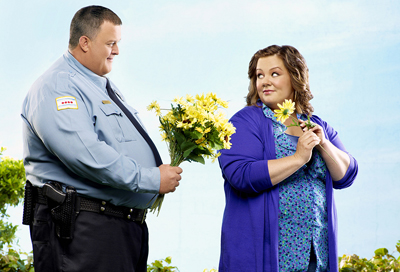"Mike And Molly" Vs. Marie Claire: The Super-Size Debate

In the wake of several early season cancellations, CBS’s new sitcom “Mike and Molly” earned a full-season pickup late last week, avoiding the axe that new series have inevitably come to fear.
Things were looking up for the freshman comedy starring two obese and lesser-known actors—Billy Gardell and Melissa McCarthy—as the titular characters who meet at an Overeaters Anonymous meeting.
That is, until Monday when Marie Claire blogger Maura Kelly posted a brutal entry on the magazine’s website entitled “Should ‘Fatties’ Get a Room? (Even on TV?)”.
“I think I'd be grossed out if I had to watch two characters with rolls and rolls of fat kissing each other,” she writes. “Because I'd be grossed out if I had to watch them doing anything.”
The blog entry sparked a great deal of controversy in the form of more than 1,500 comments and 28,000 e-mail responses, according to The Hollywood Reporter.
Kelly, a self-professed former anorexic, later posted an apologetic statement.
Despite the alarming number of overweight Americans in today’s society, few other shows in the history of scripted television have taken the risk of casting two heavyset people in leading roles. So naturally the decision generated a great deal of buzz in the media. Countless review headlines played on words like “appetite,” “thin,” “calories” and “menu.” Critic after critic pointed out the fat-joke-laden premiere episode.
But at CBS’s Television Critics Association Summer 2010 Press Tour, before the show even premiered, executive producer Chuck Lorre made every effort to deflect attention away from the leading characters’ waistlines.
“This may sound ridiculous to some of you, but this isn't a show about weight,” said Lorre, the man behind other successful comedies such as “Two and a Half Men” and “The Big Bang Theory.” “It's a show about people trying to make their lives better and find someone that they can have a committed relationship with…If we're talking about this issue come episode six, we've got a serious problem because it would get tired really quickly. It's not enough to hang a series on—not by any stretch of the imagination.”
CBS purposefully positioned “Mike and Molly” more as a relationship comedy than a show about overweight people, according to publicist Andrea Ballas, who worked in conjunction with the network’s marketing department to promote the show. Billboards advertising the series featured a picture of Mike planting a sweet kiss on Molly’s forehead with the barebones tagline “A new comedy from the creator of ‘Two and A Half Men’”—not a single mention of their size, a dig at their BMI or a joke at their expense.
But no matter how hard CBS tries to downplay their larger than life waistlines, the effects of putting “real”-looking Americans on broadcast television has consequences—for better or for worse.
USC Associate Professor of Research of Health Promotion and Disease Prevention, Donna Spruijt-Metz, has studied the adverse effect of thin media on the body image of young kids, especially girls. Many times, instead of inspiring people to get in shape, it makes them feel hopeless in their fitness quests, causing them to give up and overeat. Although she isn’t sure yet what effect a show like “Mike and Molly” might have, she says she believes in the power of media and entertainment.
“Let’s face it—one of the reasons everyone is so fat today is because of media,” Spruijt- Metz said. “Fast food restaurants, packaged foods and General Mills all really know how to use it. If we want to make any difference in this world, we’ve got to meet fire with fire and bucks with bucks. It’s expensive the good media. But it’s incredibly incredibly forceful and it changes people’s lives.”
Registered dietician and Assistant Professor of Preventative Medicine Jaimie Davis underscored the severity of today’s obesity epidemic, especially among children. According to U.S. Centers for Disease Control and Prevention reports, as many as 34 percent American adults would be considered obese and roughly 17 percent of children. She worries that fat media might encourage children that it is accepted to be overweight and/or obese in our society.
“Many people—adults and kids—who are overweight make jokes about it as a way of ‘coping’ with this issue. I’m not sure if this is a healthy approach. It’s easier to hide behind the jokes than to address the underlying issues.”
But Los Angeles Times television critic Robert Lloyd aligns himself more with CBS, insisting that the appeal of “Mike and Molly” has almost nothing to do with its more than pleasantly plump stars.
“Every sitcom starts out with a premise,” he said. “It’s sold along lines that are very specific and kind of exaggerate certain features in the show because the project goes through whatever levels of pitching and development it has to go through. You need this kind of big idea that everyone can grab onto.”
Now six weeks into the fall television season, it’s becoming clear that “Mike and Molly” has edged out some of its newcomer competition, boasting an average 12.3 million viewers an episode and that full season pickup. But any successful TV show needs more than an innovative twist to bring viewers back week after week and season after season.
“People tune in to sitcoms because they like the company,” Lloyd said. “They like to hang out with these people for whatever reason. If you don’t have that quality, it really doesn’t matter what else you have.”
Reach reporter Kelsey Borresen here.



